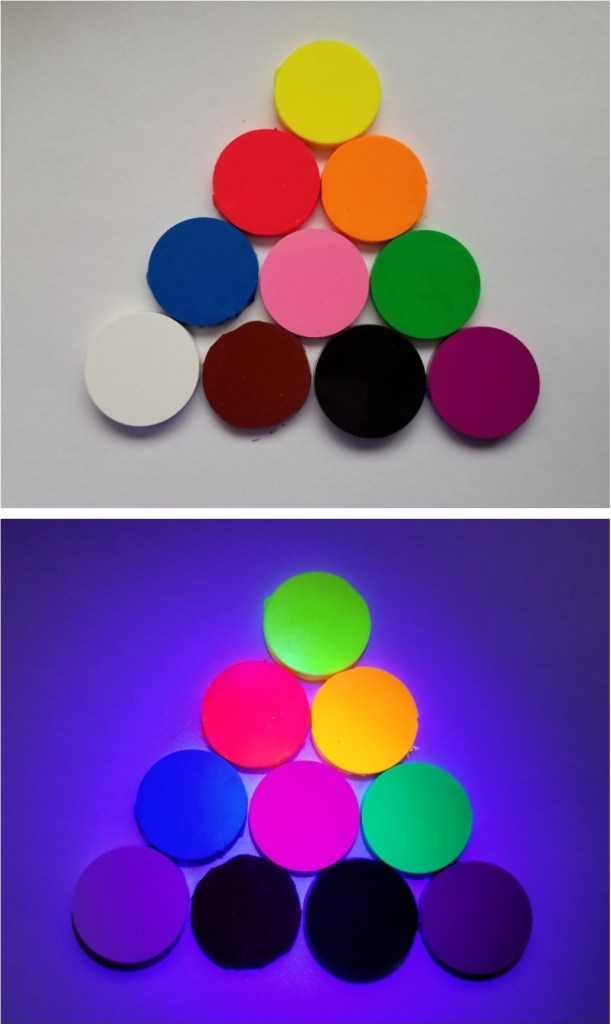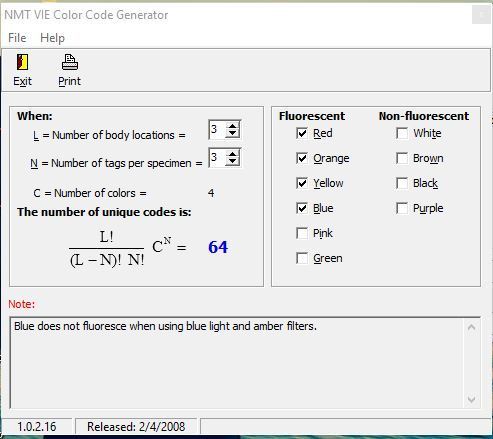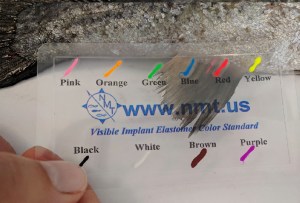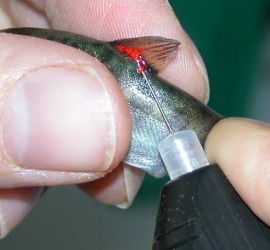魚類螢光標記試劑 (VIE標籤) VISIBLE IMPLANT ELASTOMER TAGS
魚類螢光標記試劑 (VIE標籤) 小巧、靈活且具有生物相容性,這使得它們可用於多種物種。
用於標記甲殼類動物、頭足類動物、腹足類動物、爬行動物、兩棲動物、小型哺乳動物、蛛形綱動物和其他動物。
以液體形式注入,固化成柔韌的固體。標籤植入透明或半透明組織下方,並保持外部可見。
如有需求,請洽業務人員
Color Selection
Visible Implant Elastomer comes in 10 colors. Red, pink, yellow, green, orange and
blue are fluorescent. Black, purple, brown, and white are not. The fluorescent colors
are highly visible in ambient light and provide the option of greatly enhanced tag
detection when fluoresced with the VI Light. Fluorescing the tags is especially helpful
when tagging under pigmentation or when recovering tags in the dark.
This video about tagging glass eels to evaluate dam passage shows how effective
the fluorescence can be.
VIE color selection can be tricky and getting it right is an important part of your
experimental design. Your choice depends on how much contrast you need with the
background pigmentation, how many different colors you require, and the type of light
you will use to fluoresce the tags.
 Visible Implant Elastomer is available in 10 colors, shown on the top, in ambient light. Red, green, yellow, orange, blue, pink and green fluoresce under the VI Light (bottom photo).
Visible Implant Elastomer is available in 10 colors, shown on the top, in ambient light. Red, green, yellow, orange, blue, pink and green fluoresce under the VI Light (bottom photo).
General recommendations
- Exhaust all possibilities with fluorescent colors before using non-fluorescent colors.
Maximum tag detection is obtained by fluorescing tags with the VI Light. - Use non-fluorescent colors only when there is no potential for the tag to become
obscured and when all tag detection will occur in bright light. - When using the VI Light, we recommend that the first four colors selected be
red, yellow, orange, and blue. - Test the product under field conditions before beginning large-scale projects.
Colors that may be confused when using the VI Light:
- Green and yellow appear nearly identical.
- Red and pink look similar but can be separated if the VIE Color Standard is used
and if the samplers are trained. We recommend that you test these two colors in
your animal and with the samplers who will recover the tags.
Colors that may be confused in Ambient Light:
- Black and brown appear nearly identical.
- Brown and purple look similar. With the VI Light, purple will appear much lighter
while brown does not change. This feature may be used to help distinguish these
colors.
Generate a Coding Scheme
While VIE is primarily used for batch identification, you can generate a VIE coding
scheme by combining multiple tags, tag locations, and colors. For example,
researchers tracking seahorses used this method to distinguish more than 500
individual seahorses at one time.
Six fluorescent colors (red, yellow, blue, orange, green, and pink) and four
non-fluorescent colors (black, brown, white, and purple) constitute the only intrinsic
VIE codes. If you use just one tag per fish, the number of unique codes is simply the
product of the numbers of colors used and the number of tag locations.
However, if you inject two or more tags in each animal, in combination with several
different locations and colors, you can generate an extensive VIE coding scheme.
In any tagging program, it is important that all of the study animals have the same
number of tags. That way, there can be no confusion between animals which lost tags
and those which began with fewer tags.
 Use NMT’s app to generate a VIE coding scheme.
Use NMT’s app to generate a VIE coding scheme.
How many codes?
Calculate the number of unique codes you could create using the formula:
[L!/(L-N)!N!] CN
Where: C= Number of colors used, L= Number of body locations and N =
Number of tags per animal.
For example, three body locations used with four colors (C = 4, L = 3, N = 3) would
provide: (3!/0!3!)43 = 64 unique codes. Recall that 0!=1.
There’s an app for this! NMT’s VIE Color Code Generator quickly calculates and lists
the unique codes available for a given combination of body locations, tags and colors.
VIE Tag Detection
A powerful feature of Visible Implant Elastomer tags is that red, pink, yellow, blue,
orange, and green can be fluoresced for enhanced detection. When fluoresced,
a small spot of VIE can be seen at considerable distance and in the dark, and tags
obscured by pigmentation are often detectable. However, color perception can vary
among samplers. Tags of different colors can generally be distinguished in ambient
light in clear tissue, but those same colors may be confused if the marks are poor or
are placed under pigmented tissue. Fluorescing the tags greatly enhances tag
detection, but red and pink, and green and yellow, look similar when fluoresced.
Maximize Tag Identification
- Choose distinct colors for tagging.
- Tag in clear tissue whenever possible.
- Train your samplers – let them practice with the tag colors they will encounter
before they start collecting data. - Use the VIE Color Standard to correctly identify colors.
- Use the VI Light to fluoresce poor or obscure tags.
 Using the VIE Color Standard to compare tag colors.
Using the VIE Color Standard to compare tag colors.
VIE Color Standard
NMT’s VIE Color Standard presents the ten VIE colors on a clear card. This allows the
sampler to place the color sample directly beside a tag for comparison, either under
or over the tagged tissue.
Customized color standards can be made at the time of tagging by dispensing some
tags onto clear stiff plastic and then covering them with clear packing tape after the
marks have cured. Labeling the colors is helpful.
Test the VI Light with the VIE Color Standard to ensure that the tags are adequately
fluoresced. Shine the light directly on the area where the tag is thought to be. If you
are working in direct sunlight, you will need to fluoresce the tags in the shade – even
the shade of your body is probably enough. Very faint tags are best seen when
fluoresced in darkness.
CAUTION! Our VI Lights are very bright, but you can hardly see their light.
They do not trigger the eye’s normal defense mechanisms against bright light.
Never stare directly into any light used for fluorescing VIE tags, and keep these
lights out of the reach of children.








